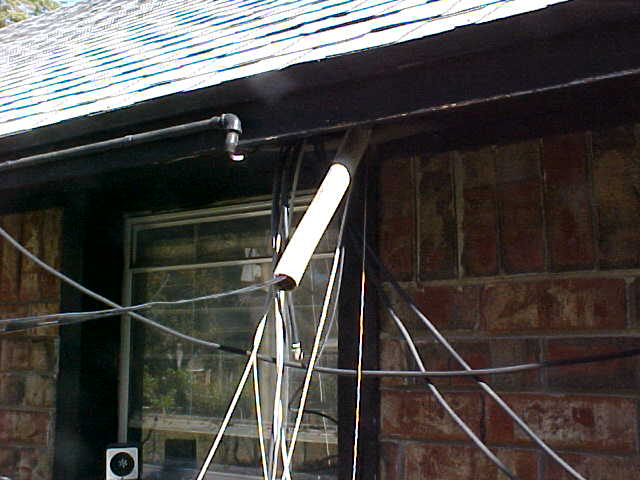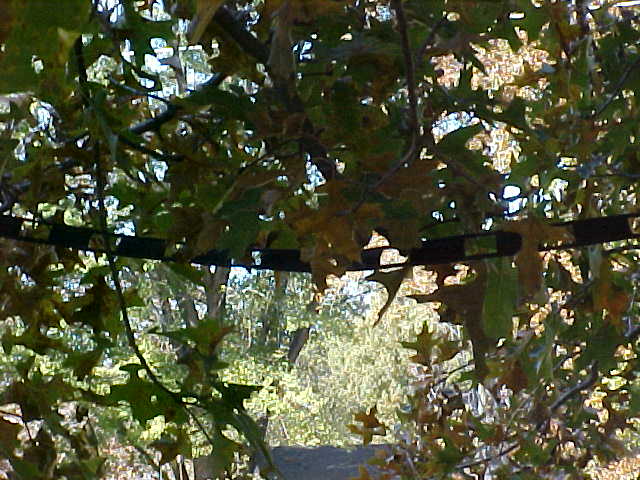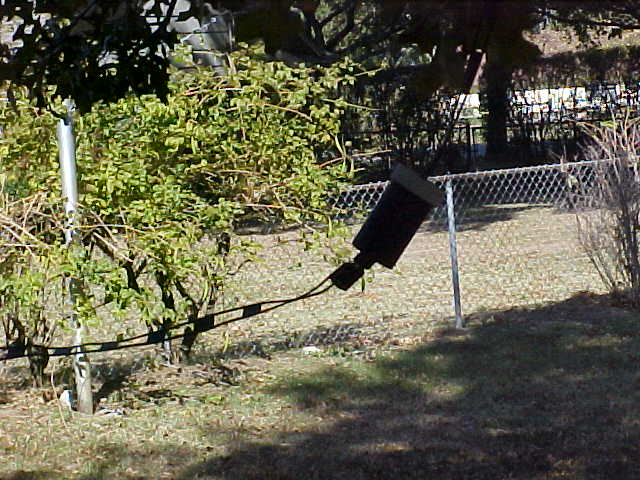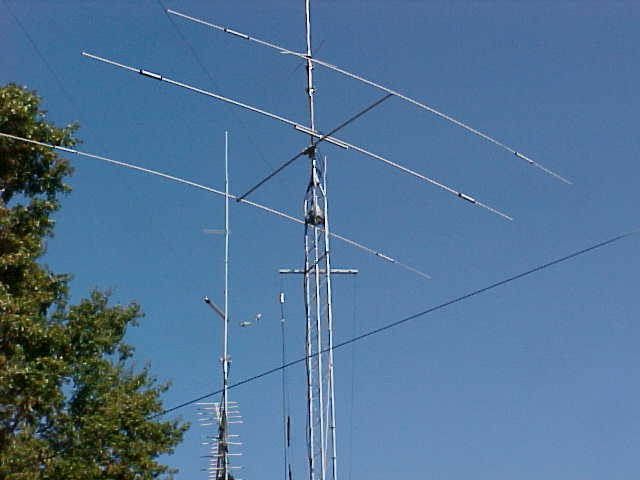K5LAD's Assorted Ham Stuff
"I can’t work 80 meters, I don’t have a good 80 meter antenna"
How many hams have made a statement like the title of this piece? Quite a few, I’d be willing to bet. There are numerous reasons why people shy away from trying to put up a good antenna for this band:I don’t have enough room for a full-length antenna.
I can’t get an 80-meter antenna high enough to do any good.
You can’t work DX without some kind of directional antenna and that’s not very possible on 80.
Takes too much wire.
I could put something up but the coax would be too long and lossy.
I could put something up but the coax would be too expensive.
I’m sure there are several other reasons you could give but I’m here to tell you, I’m running an 80-meter antenna that, by all definition and rules of antenna theory, it shouldn’t work. At least, it shouldn’t work as well as it does. Let me describe this strange quirk of physics and then I’ll enumerate some of my success with it.
My antenna is 130 feet long, made of #12 stranded wire. It’s fed in the center with 450-ohm ladder line and I use a Ladder Grabber center insulator, which is an excellent product from EmTech of Tracyton, Washington. It cost me only $8.00 postpaid when ordered through the Internet and a recent check shows it still the same price.
[The "blob" on the left side of the insulator is not some secret trap material made to make it work better. It's a piece of leaf which got wrapped around the wire and it was just too far away for me to reach.]
Antenna purists will tell you that unshielded feedline, such as ladder-line, should always be supported away from touching metal, wood, trees, or anything which could upset the balance feature of the line. I believe that theory and I’d certainly do that if I could. Where the feedline exits the house I do use an insulated PVC flexible hose to (sort of) keep it away from the other coax feedlines.
[Some day I'm going to gather up all these feedlines to make them look nicer............maybe next week........ or next month]

From the point where the feedline exits the attic over to the center insulator of the antenna, I’d like to keep it totally clear of everything, however, I just couldn’t do that. I’ve got a big tree in the way so I just wove the ladder-line through the branches. As I mentioned, an antenna purist would NEVER weave this feedline through a tree………. but I’m not an antenna purist. I’ve mentioned before, in other articles, that my antenna theory is, do the best you can. Put up the best antenna you can, as high as you’re able and then just use it. You’ve done the best you can so just use it and enjoy it.

[It's difficult to see the 450-ohm ladder-line as it threads through the tree but if you squint just right, you'll see it. I made no effort to isolate the feedline from the branches.]
Another thing, which will make antenna purists wince, is the coupling I added to my ladder-line antenna. I planned to experiment with various antennas fed with 450-ohm ladder-line so out among the tree branches I terminated my ladder-line with a pair of banana jacks mounted in an old pill bottle. Then, when I built another antenna I could plug it into this coupling and try it out. So far I’ve not tried any other antennas since my first one worked so well. The ladder-line feedline coming from my 80-meter antenna is terminated in a pair of banana plugs that plugs into the coupling at eye level. So far it has weathered and worked quite well.
[This is the pill bottle connection to allow hooking various experimental antennas to the ladder-line coming from the hamshack. It's not completely waterproofed so I periodically have to dump the water from it.]

Well, at least I know I should have my antenna up pretty high. A full wavelength would be optimum but it should be at least a half wavelength. On 3.750 MHz, a full wavelength would be just short of 250 feet, which, for me, is far more than impossible, and not even within the "dreaming range." Even a half wavelength is almost 125 feet and that’s not even a possibility for me. I do have several towers but the shorter one is only 39 feet and that’s what I had available for an end support for my 80 meter antenna. Actually, the support bar where it’s hooked is at 38 feet or so above the ground. Currently, I have a deep lot with an acre and a quarter but I have nothing at the back part of my lot for an anchor so the other end of my antenna is tied to the fence and is no more than 4 1/2 feet off the ground. Certainly this antenna would qualify for a good NVIS antenna but this is not NVIS territory.

[This tower is a 40 foot Rohn 25. The bracket where the antenna's pulley is attached is a foot or so below the rotator. The picture on the right shows this bracket up a bit closer. This is the HIGH end of the antenna.]

[The left picture shows the end of the antenna running out to attach to the fence. The grey end insulator is just about in the center of the picture. The right picture shows that same end insulator from the other side and gives a good idea how low this antenna really is. You might be able to see the ladder-line feed coming out from the tree.]
WHAT? A successful 80 meter antenna that’s only 38 feet high on one end and 4 1/2 feet on the other? Yep, that’s what I’m saying. How good is it? The following are some of the stations I have contacted on 80 meters with my strange antenna:
ZL1IU – New Zealand - April 2007 – SSB
3B7C – St. Brandon Island – September 2007 – SSB
OK5R – Czech Republic – March 2007 - SSB
HC8N – Galapagos Islands – October 2007 - SSB
AO8A – Canary Islands – October 2007 – SSB
ZY7C – Brazil – October 2007 – SSB
ON4UN – Belgium – March 2007 – SSB
HG3DX – Hungary – March 2007 – SSB
CN2R – Morocco – October 2007 – SSB
C52C – The Gambia – October 2007 – SSB
KH7XS - Hawaii – November 2007 – SSB (now twice)
OE6MBG - Austria - November 2007 EI6S - Ireland - November 2007Many stations in the Caribbean area
Every time I get ready to try to work a DX station on 80 meters I tell myself, "There’s no way I can get to them with that low-down antenna. I have not, however, told my antenna that information so it continues to surprise me and continues to produce good and surprising contacts. Perhaps all the praise should go to the abilities and equipment of these stations on the other end. I have no doubt that plays a part but the fact remains that my signal, hugging the earth, seemed to somehow get to where they are.
I should also describe the other end of this antenna. When the ladder-line enters the attic it runs for a while and attaches to a large 4:1 balun. This balun is fed with 50-ohm coax, which runs the rest of the distance into the hamshack, a distance of less than 15 feet. The coax runs to my Dentron MT-3000A antenna tuner, which takes care of any misadjustments. I do run a kilowatt and I must admit that power here often helps a great deal. It’s often been said that it’s better to have an extra good antenna rather than high power because the antenna helps on both the transmitting and the receiving end. In my case, however, I didn’t have the opportunity to put up any better antenna so this one seems to work well enough on both sides.
Most of this article has dealt with the use of this antenna on 80 meters but it goes without saying that if you are actually running your antenna through a good antenna tuner, you can cover all ham bands from 160 - 10 meters and all the frequencies in between. This antenna would be a good choice for an antenna when the ham could only put up one antenna. My friend Jerrie - KD5KD has been using an antenna like this with great success on his Navy MARS net which is near the 80 meter band. Jerrie has his antenna mounted as an inverted V with the center at about 38 feet and the ends drooping down to around 20 feet off the ground.
Note that I said "
through a good antenna tuner" and that doesn't particularly mean an expensive antenna tuner. I would recommend an external tuner be used, either a manual or automatic model. Many folks consider their antenna tuner to be the auto tuner build into their transceiver but most of those tuners have a limited range. Typically, the tuners built into commercial transceivers cannot tune anything above about a 3:1 SWR (about 20 to 150 ohms) and that may be insufficient to tune this antenna on some frequencies. A good external tuner may be able to match impedances from 5-10 ohms to over 1000 ohms. This is particularly important if you plan to use this antenna over a wide range of bands and frequencies.By the way, this antenna runs roughly from Northeast to Southwest. At this low altitude, however, I doubt that the pattern is anywhere close to a typical dipole's pattern. I suspect that if I tried to run the figures for this antenna through an antenna modeling program it would come to a screeching halt and display the message, "You've GOT to be kidding!!!"
My final advice is – If you want to put up an 80-meter antenna but you hesitate because you think you can't have any success, I'd say, "just do it." Do the best you can with what you have available. Put up what you can and as high is you can. Even though it’s not an antenna which is destined to be displayed on the cover of CQ Magazine, just go ahead and use it and enjoy it. It might just surprise you.
========================================================================
Created November 7, 2007
Page visited 2086 times
Last updated 11/06/2012 16:59:21 PM
Back to K5LAD's Assorted Ham Stuff Menu